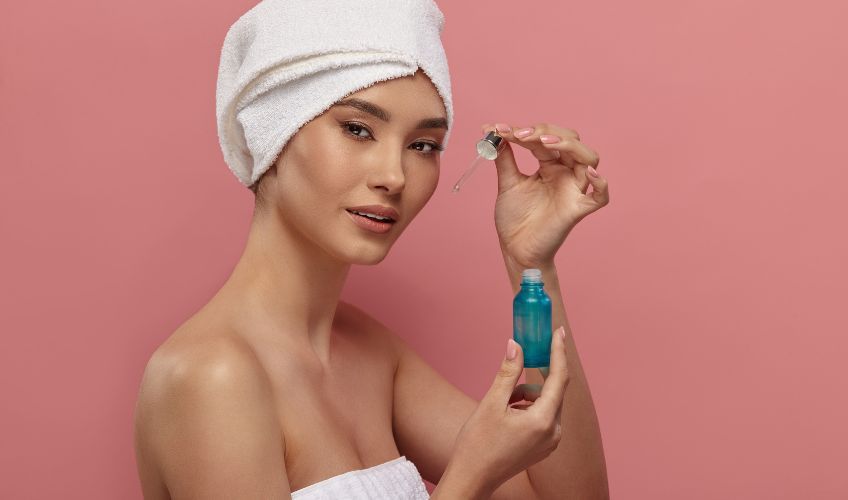Both nature and cosmetic science offer us ingredients that significantly benefit our skin. In the pursuit of maintaining healthy, youthful, and glowing skin, experimenting with various skincare ingredients is crucial. However, understanding what benefits your skin and what doesn't is equally important.
In the realm of beauty products, retinol stands out as a favored ingredient for revitalizing the skin and addressing aging signs. It is a proven solution for mature skin. Tretinoin, a stronger and more powerful version of retinol, operates similarly but is available only with a prescription.
This article explores whether using retinol and tretinoin simultaneously is advisable.
canvaRetinol (1) is well-regarded in skincare for its anti-aging effects. This vitamin A derivative is commonly found in many over-the-counter products.
Retinol

As we get older, the renewal rate of our skin cells slows down, causing fine lines and wrinkles. Retinol speeds up this renewal process, helping to reveal smoother and more radiant skin. Not only does it help prevent and reverse aging signs, but it also enhances the overall texture and tone of the skin.
Retinol can bestow a more youthful appearance by revitalizing and clearing the skin.
Tretinoin
Tretinoin (2) is a prescription-strength topical treatment derived from Vitamin A. This potent component may lead to skin irritation.
However, it is highly effective in treating acne, hyperpigmentation, sun damage, and the signs of aging. Tretinoin works by improving the skin's clarity, smoothness, and reducing pigmentation.
Benefits of Using Retinol and Tretinoin Together
Tretinoin accelerates skin cell turnover, revealing a refreshed complexion.
When combined, retinol and tretinoin offer multiple advantages:
1. The combination of retinol and tretinoin can enhance skin texture and minimize aging signs.
2. While tretinoin treats acne and hyperpigmentation, retinol rejuvenates and improves skin tone and texture.
Potential Risks of Using Retinol and Tretinoin Together
Although using retinol and tretinoin together can be advantageous, it also comes with some potential downsides.
1. Skin Irritation
Both retinol and tretinoin have the potential to irritate the skin, causing issues such as redness, dryness, and peeling. Using them concurrently might increase this risk, especially for those with sensitive skin.
2. Sensitivity to the Sun
These compounds can also heighten your skin's sensitivity to sunlight, making you more susceptible to sunburn. Therefore, incorporating sunscreen into your skincare routine is crucial.
3. Over-exfoliate
Given that both retinol and tretinoin act as chemical exfoliants, using them together may elevate the risk of skin irritation, compromise the skin barrier, and increase sensitivity and redness.
Using both retinol and tretinoin simultaneously can result in significant skin irritation.
Since these products are Vitamin A derivatives with similar effects, combining them isn’t necessary. Using both might cause skin irritation and speed up side effects, leading to increased dryness and sensitivity.
Can You Use Retinol and Tretinoin Together?
Hence, it's generally advised not to apply these products together.
However, if you decide to do so, follow safety precautions. Consider these steps before using retinol and tretinoin in conjunction:
1. Consult a Dermatologist
Consult a dermatologist before starting any skincare regimen involving retinol and tretinoin to get tailored advice for your skin type and issues.
2. Start with Low Concentration
Begin with low concentrations of both products. Use them on alternating days to allow your skin to adjust. If your skin tolerates this well, you can gradually increase the frequency.
3. Use a Gentle Cleanser and Moisturizer
Use a gentle cleanser and a quality moisturizer suitable for your skin type to counteract the drying effects of retinol and tretinoin. A high-quality moisturizer tailored to your skin type is recommended.
4. Apply Sunscreen Daily
As these products make your skin more prone to sun sensitivity, applying sunscreen (3) is vital to shield your skin from sunburn and damage. Use a sunscreen with adequate coverage and a high SPF.
5. Monitor Your Skin
Monitor your skin's reaction to the combined use of retinol and tretinoin. If you observe signs of excessive dryness, redness, or irritation, stop using the products immediately. You might need to reduce their frequency and seek advice from a dermatologist.
Conclusion
When used cautiously, combining retinol and tretinoin can be effective in certain skincare routines. However, since both are retinoid derivatives, using them together may lead to excessive dryness, worsening flakiness or peeling.
As a result, exercise caution and seek advice from a dermatologist should you encounter significant irritation or any negative symptoms.
Relevant Articles
When Can You Wash Your Face After Botox?
What are the Differences between Essence and Serum for Skin?